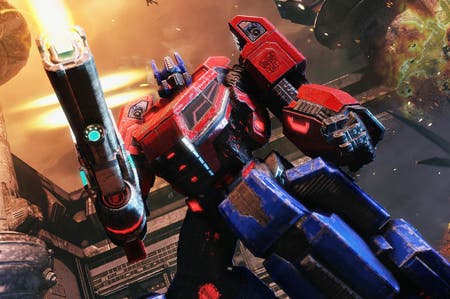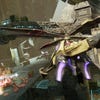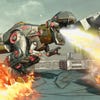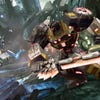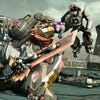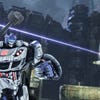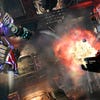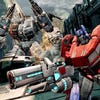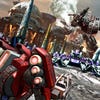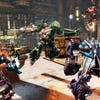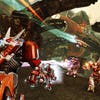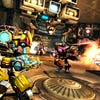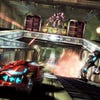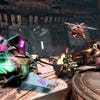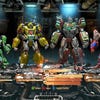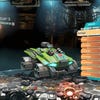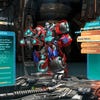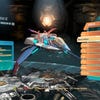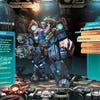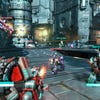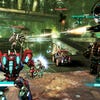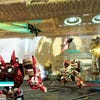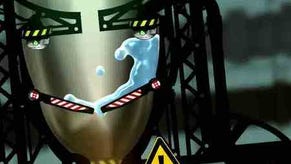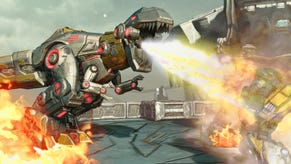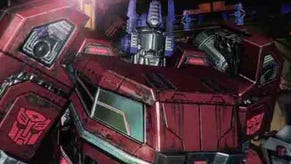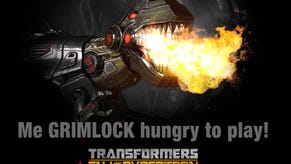Transformers: Fall of Cybertron Review
Light metal.
Good news: you don't need to have played the last Transformers game, War for Cybertron, to enjoy this sequel to that 2010 third-person shooter. [War for Cybertron is only the last if you ignore last year's film tie-in Dark of the Moon, but ignoring that would probably be for the best - Ed.] It's more a do-over than a sequel, and the essential plot is no more than 'good robots fighting bad robots as their home planet dies'.
Bad news: if your knowledge of Transformers' 30 years of back-story and lore only extends as far as 'the big red one often punches the big silver one', you're probably going to be confused at regular intervals. Fall of Cybertron is a love-letter to a fictional universe created in 1984 that has, despite a few commercial wobbles and a half-dozen reboots, continued to this day. It's aimed squarely at the long-term fans, rather than those unfortunates who believe Michael Bay's trilogy of military-worshipping car advertisements represent some sort of cinematic high watermark.
Good news again: I'm one of those long-term fans, and so can attest to being pretty damn delighted by a rampage of references, homages and oblique nods to what's known as Generation One - the original Transformers stories and toys. While War for Cybertron contained fewer types of Transformer than the average six-year-old had scattered across their bedroom floor in 1986, this is crammed full of the blighters and has a chatty ball with their relationships.
Apart from some overly portentous encounters between Optimus Prime (he's the big red one I mentioned earlier) and Megatron (the big silver one who has an evil voice, so you can tell he's evil) - and setting aside a laughably overblown gods-at-war soundtrack - the dialogue is witty and playful, characters are well if broadly sketched and it's free from the vaguely obnoxious, chest-thumping tone that often infects contemporary shooters. The metal planet of Cybertron might be dying, as evidenced by the often spectacular but inaccessible backdrops to the levels - but this is a party, not a wake.
Bad news again: Fall of Cybertron gets so caught up in celebrating Transformers: the fiction that it forgets to do much with Transformers: the transforming. I'll say more on that in a moment, but first, here's how the game's campaign structure works.
Beloved characters are wheeled on for their identibot-blasting moment in the sun, to minutely advance the minute plot, to spout a line from the increasingly beloved '80s animated movie and to have a bit of fun with a bespoke special ability. Then they're quickly wheeled off so someone else can take the spotlight for the next level.
It's the dizzying pace of this, and a certain degree of presumed knowledge about who's who, that means sensible human beings who've avoided a long-term fascination with reconfigurable plastic might well feel a bit bewildered. I'm reasonably confident they'll enjoy themselves even if they don't have the faintest clue what the hell's going on, however.
Each level is themed around a particular character, or sometimes pair of characters, usually offering a slightly different challenge to reflect their distinct power. So Cliffjumper gets a stealth level for his invisibility, Jazz gets a series of high platforms to use his grappling hook on, Soundwave can eject his chest-stored minibot minions into the fray, giant combo-bot Bruticus gets huge spaces full of destructible scenery to smash through, and so on.
This is a vast improvement on War for Cybertron's treatment of its characters as essentially interchangeable, roving through metal tunnels in gangs of three and doing nothing but shoot armies of generi-bots who didn't much look like Transformers. But it's not a vast improvement on the fact that the earlier game offered little to no reason to transform outside of pre-scripted sequences. Like its predecessor, the unfortunately-abbreviated FOC is a shooter first and foremost, and transformation is a sort of bolted-on extra that the single-player game regularly appears to forget about entirely.
Most levels will include a sudden bit of long road that would be too boring to run across, so that's a prompt to transform your robot into the indistinct, blocky, wheeled thing that represents its Cybertronian vehicle mode. Occasionally you might run out of ammo in bot mode, so transforming will mean you can use your vehicle's gun until you find a pick-up - but there's no tactical purpose to it, nor any challenges built around what transformation can entail.
Essentially, Fall of Cybertron isn't anything more than a shooter starring robots, some of which are very familiar to children of the '80s. It has lots of dramatic set-pieces and some agreeable, if throwaway and often scripting-dependent, gimmicks. It's not Transformers as the engineered, reconfigurable objects that our parents probably hoped were teaching us some sort of spatial logic when they bought them for us; but it is Transformers as the improvised battles we lived out by bashing toys against each other in the schoolyard.
When you get to play as Bruticus (a sadistic behemoth constructed from five Decepticons stuck to together) or Grimlock (a robotic T-rex who can breathe fire and eat other robots) it's sheer indulgence in a decades-old sci-fi playground of the imagination. While the rules, scripting and limitations are often far too obvious, I absolutely relished the childhood power fantasy.
Transformation takes a more active role in Fall of Cybertron's sparse but solid multiplayer. Large, multi-storey maps require vehicular modes in order to quickly reach the action. More thrillingly, rapid-fire transformation can save your neck in the midst of a battle against a powerful, all-too-aware human opponent. The vehicles can dodge faster and outrun homing rockets, while aircraft modes allow access to high-up sniper vantage points.
Unlike the single-player campaign, where you'll see characters in vehicle mode as rarely as you change to it yourself, transformation happens all the time in multiplayer. Granted, it's mostly for the initial cross from spawn point to frontline, and again for access to ammo when your bot-mode runs out, but it does at least feel part and parcel of both action and tactics. You also get to build and upgrade your own robot from parts of the characters in single-player, although there's not quite enough on offer to feel you've created anything unique - especially as vehicle modes are by and large unaffected by which robot parts you select.
With a fairly limited and uninspiring range of maps, and guns and new robot parts to unlock, I'm not convinced that Fall of Cybertron's multiplayer has all that much gas in its tank despite its immediate joyfulness. With three downloadable character model packs on the way, Activision is doing something to ensure longevity - but given PC gamers have discovered that the files for all these are already in the game, any long-term player faith in the multiplayer is perhaps not deserved. I'm expecting a happy couple of weeks trying to unlock the Metroplex and Grimlock heads, mind.
Fall of Cybertron is the game Transformers fans wanted, for sure: a litany of homages and celebrations and a marked improvement on the washed-out smallness of War for Cybertron. For all that, it's not quite the game Transformers deserves, failing as it does to expand or explore the possibilities of reconfigurable characters. It's exactly what meets the eye - which is to say a good-hearted festival of a game about talking robots shooting and smashing each other, shouting itself raw-throated in joy at the toys it gets to play with, but no more than that.
